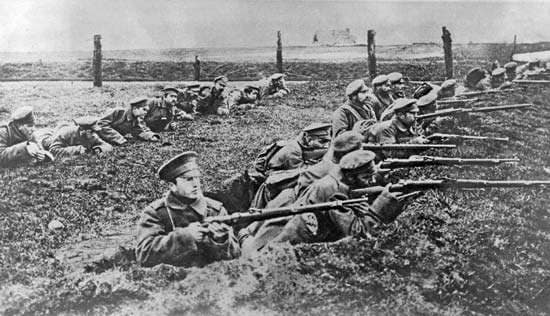
World War I, started by the tactless act of the Austria-Hungarian Archduke's assassination, resulted in massive global horror. Stretched to four years, the war introduced lethal chemical weapons, horrific trench warfare, and tank battles. Ending in 1918, WWI altered the geography of the four imperial Dynasties (the Germans, Austria-Hungarian, Russian, and Ottoman Empire, and resulted in almost 16 million casualties.
Given its historical significance, everyone should fully comprehend how it happened. This is where the World War One timeline helps! It aids the human mind in visualizing how the war occurred and impacted today's world. This World War I — chronology diagram gives you valuable insights into the triggering episodes, trench wars, and armistice.
In this article
Part 1. World War I — Chronology
Want to get some significant events in the World War one timeline? Let us visualize the episodes that triggered the World’s first and deadliest wars.
Outbreak of World War I - 1914
June 28, 1914 - Assassination of Archduke Franz Ferdinand
The heir to the Austria-Hungary throne, Archduke Franz Ferdinand, and his wife, Sophie, were traveling to investigate troop resistance in occupied Sarajevo. A Serbian nationalist student shot the couple on the way.
July 28, 1914 - Austria-Hungary Declares War on Serbia
The Austrian-Hungarian emperor Franz Joseph blamed the Serbian government for the assassination of the heir. Consequently, they declare a war on Serbia and Russia. Meanwhile, Russia calls France for military support, triggering World War I.
August 2, 1914 - Germany Invade Luxembourg and Belgium
Germany invaded Luxembourg and Belgium. Germany also declared war on Russia and France.
August 2-28, 1914 - Nations Allied Against Germany
- The Western nations allied against Germany, including France, Britain, Russia, Italy, South Africa, Montenegro, and Japan.
- France invaded Alsace.
- The British Expeditionary Force invaded France.
- The French and German forces collided, and the Battle of Frontiers began.
- The Battle of Tannenberg started in late August. The Russian army invaded Prussia and took around 125,000 prisoners.
September 6, 1914 - First Battle of Marne
The Allied forces advanced into France, marking the start of the first Battle of Marne. The Germans advanced 30 miles into Paris and dug the north of the Aisne River, marking the beginning of the Trench warfare. However, they were soon defeated by the French army and British Expeditionary Forces.
Trench Warfare 1915-1916
Trench Warfare symbolizes attack, counterattack, and defense using dug trenches from the ground.
February 18, 1915 - Britain Naval Blockade
Germany begins the naval blockade of Great Britain to break its command of the seas. The event initiated the German campaign of submarine warfare. Moreover, the second Battle of Ypres begins. The Germans launched a chlorine attack on the Allied trenches. Consequently, 5000 French and Algerian troops were killed.
April 25, 1915 - Allied Forces Land on Gallipoli Peninsula
The Allied forces landed on the Gallipoli Peninsula of the Ottoman Empire. However, their attempt to control Constantinople turned out to be a failure, with more than 200,000 casualties. It eventually led to the collapse of the British government.
May 7, 1915 - Sinking of British Ocean Liner, Lusitania
The Germans torpedoed the British ocean liner, Lusitania, on the Southern coast of Ireland. The episode killed 1200 people, 128 of whom were US citizens. It was also carrying 170 tons of ammunition and shells.
May 23, 1915 - Italy Declares War on Austria-Hungary
Italy joined the Triple Alliance alongside Britain, France, and Russia and declared war on Austria-Hungary. Upon declaration, the Italian army advanced into the South Tyrol region for an offensive operation. However, the combat settled into a stalemate due to the rough terrain.
February 21, 1916 - Battle of Verdun Begins
The Battle of Verdun started with Germany attacking France, resulting in over 700,000 casualties. The battle lasted for around ten months and resulted in the entire village being wiped from France.
May 31, 1916 - Jutland Naval Battles
The British and German fleets confronted each other 60 miles off the Jutland coast, Denmark. Though irrational and indecisive, it was the only major encounter between the two powers in WWI.
July 1, 1916 - Battle of Somme
The Allied forces started the Somme Offensive against Germany. Though they succeeded in drawing Germans out of Verdun, almost 20,000 British troops were killed in the action. The battle lasted for four months and resulted in 1,000,000 casualties.
May 31, 1916 - Battle of Verdun Ends
The battle of Verdun ends after ten months of continuous offense. It resulted in 550,000 French and 450,000 German casualties. A century after the battle’s conclusion, around 10 million shells were found in the soil around Verdun.
End of War 1917-1918
March 25, 1917 - Tsar Nicholas II Abdication
Following the weeks of riots in St. Petersburg, the capital of Russia, Tsar Nicholas II abdicated the throne. The Russian Revolution resulted in the overthrowing of the Romanov Dynasty. Consequently, Vladimir Lenin and the Bolsheviks rose to power in Russia.
April 6, 1917 - US Declares War on Germany
Four days before the US joined WWI, then US President Woodrow Wilson declared Germany’s submarine warfare the key reason behind the provocation of the US into the war. On April 6, 1917, the US announced to abandon its policy of neutrality.
November 20, 1917 - British Forces Drive Germans Away
British forces launched an offensive in Cambrai, France, marking WWI's first large-scale tank combat. The British tanks destroyed the German defenses, taking around 7500 prisoners. However, the British Expeditionary Forces returned to their original position in two weeks due to harsh weather and tough terrain.
March 3, 1918 - The Treaty of Brest-Litovsk
After inadequate manpower and constant delays, the Soviet government agreed to peace with the Central Powers. Consequently, Russia signed the Treaty of Brest-Litovsk and surrendered its Baltic and Polish territories to Finland.
November 11, 1918 - Armistice Achieved
Germany could not continue the long battle due to the threat of the revolutionary forces taking the Industrial centers and defense lines. Hence, according to Woodrow Wilson's fourteen points, the armistice was achieved between the country and the Allies,
Conclusion
World War I undisputedly remains the first deadliest global war, killing 16 million military personnel and civilians. Today, it is important to recall how it happened and continue to shape the world society. To understand its impact on the globe, this one-stop World War One Timeline is a must-have. With this, you do not have to strain your eyes and read lengthy documents.
Want to explore similar war-related timelines? Try EdrawMax. It has a massive community of 15,000+ user-generated templates, including timelines, family trees, and more. Plus, all of them are editable. So, give it a shot, and it may help you with assignments.



 below.
below.  below.
below. 


